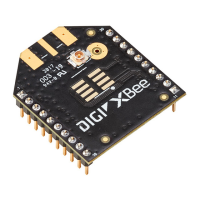Transmission, addressing, and routing Transmission timeouts
Digi XBee® 3 Zigbee® RF Module
119
n The application sends data to 10 or more remote devices, some of which are end devices.
n The end devices may sleep longer than the unicast timeout.
Equations for these timeouts are computed in the following sections.
Note The timeouts in this section are worst-case timeouts and should be padded by a few hundred
milliseconds. These worst-case timeouts apply when an existing route breaks down (for example,
intermediate hop or destination device moved).
Unicast timeout
Set the unicast timeout with the NH command. The actual unicast timeout is computed as ((50 * NH)
+ 100). The default NH value is 30 which equates to a 1.6 second timeout.
The unicast timeout includes 3 transmission attempts (1 attempt and 2 retries).
The maximum total timeout is approximately:
3 * ((50 * NH) + 100)
For example, if NH=30 (0x1E), the unicast timeout is approximately 3 * ((50 * 30) + 100) or one of the
following:
n 3 * (1500 + 100)
n 3 * (1600)
n 4800 ms
n 4.8 seconds
Extended timeout
The worst-case transmission timeout when you are sending data to an end device is a larger issue
than when transmitting to a router or coordinator. As described in Parent operation, RF data packets
are sent to the parent of the end device, which buffers the packet until the end device wakes to
receive it. The parent buffers an RF data packet for up to (1.2 * SP) time.
To ensure the end device has adequate time to wake and receive the data, the extended transmission
timeout to an end device is:
(50 * NH) + (1.2 * SP)
This timeout includes the packet buffering timeout (1.2 * SP) and time to account for routing through
the mesh network (50 * NH).
If no acknowledgment is received within this time, the sender resends the transmission up to two
more times. With retries included, the longest transmission timeout when sending data to an end
device is:
3 * ((50 * NH) + (1.2 * SP))
The SP value in both equations must be entered in millisecond units. The SP command setting uses 10
ms units and must be converted to milliseconds to be used in this equation.
For example, suppose a router is configured with NH=30 (0x1E) and SP=0x3E8 (10,000 ms), and that it
is either trying to send data to one of its end device children, or to a remote end device. The total
extended timeout to the end device is approximately:
3 * ((50 * NH) + (1.2 * SP)) or one of the following:
n 3 * (1500 + 12000)
n 3 * (13500)

